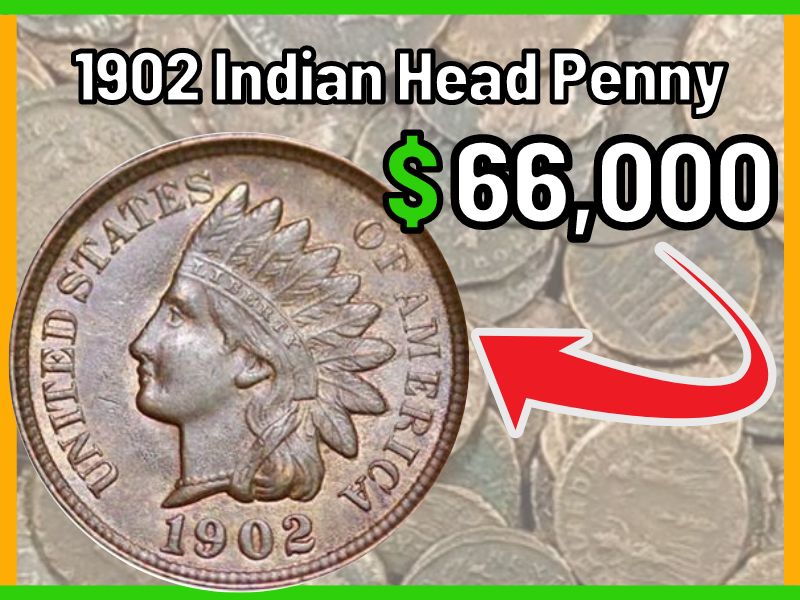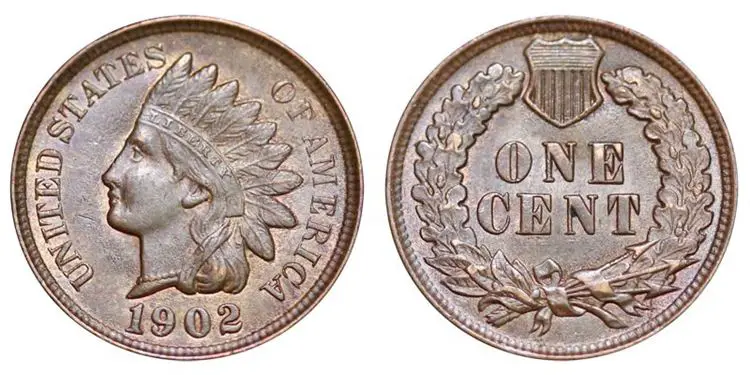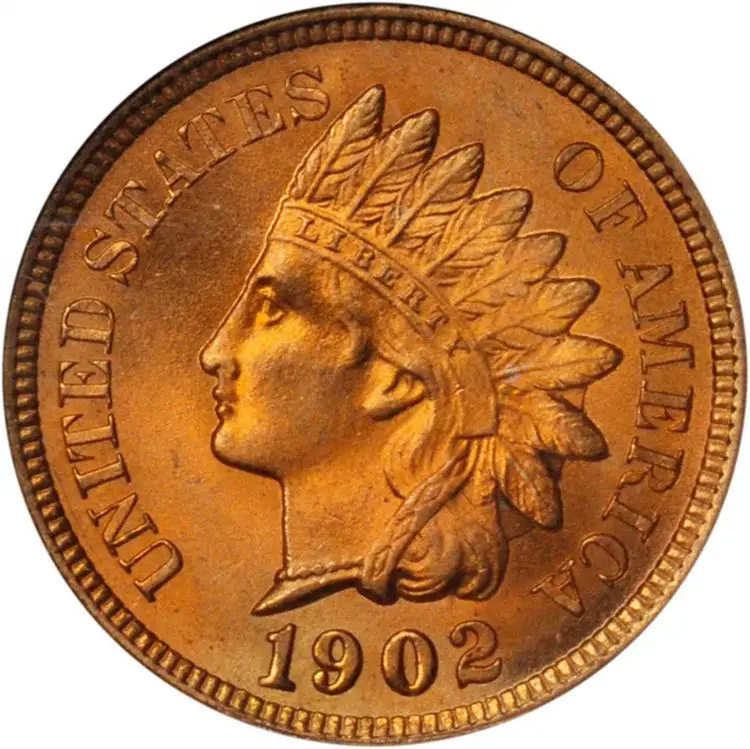
Circulated coins are typically worth $2 to $10, while uncirculated coins can be worth anywhere from $50 to over $40,000. The most important factor in determining the value of an uncirculated coin is its patina, which is the natural oxidation that forms on the surface of the coin.
For some people, collecting old pennies is a hobby. They may enjoy the process of searching for rare coins, or they may simply take pleasure in the beauty of antique currency. Whatever the case, old pennies can be a valuable addition to any collection.
Are you a coin collector? If so, you’ll want to check out the value and price chart for 1902 Indian Head pennies. These copper coins are worth more than face value, so it might be time to add one or more of them to your collection! Keep reading to find out more about this interesting penny and its value.
What are Indian Head Pennies?
The Indian Head Penny was minted by the United States Mint from 1859 to 1909. The obverse features the profile of a Lady Liberty with an American Indian headdress, while the reverse features the image of a wreath made of three arrows and oak leaves.
The coins are made of copper and nickel, and were initially intended to replace the large and unwieldy half cents that were then in circulation.
The Indian Head Penny was designed by James Barton Longacre, the Chief Engraver of the United States Mint. Longacre was inspired by the popular Gold Rush-era $20 Liberty Head Double Eagles, which featured a similar profile of a Native American on the obverse. The flying eagle on the reverse is adapted from Longacre’s earlier design for the flying Eagle cent.
The Indian Head Penny was minted at all three US Mints: Philadelphia, San Francisco, and New Orleans. Over its 50 year production run, nearly 300 million Indian Head Pennies were struck. Today, the coins are highly collectible, and many examples can be worth hundreds or even thousands of dollars.
1902 Indian Head Penny Identification Guide

Photo: usacoinbook
The 1902 Indian Head Penny is an iconic coin that is highly sought-after by both novice and experienced collectors alike. This guide will help you identify this valuable coin so that you can add it to your collection.
The 1902 Indian Head Penny is composed of 95% copper and 5% tin and zinc. The total weight of the coin is 3.11 grams. The original color of the metal is reddish-brown, however, it can change over the years. A coin patina is a thin layer of oxide that forms on the surface of a metal coin. The Patina protects the coin from further deterioration and gives it a unique appearance. Coins can develop a patina over time due to exposure to the elements, or they can be deliberately treated to create a desired look.
In 1902 Indian head pennies, three types of patina can be found: brown patina, red brown patina, and red patina. Each type of patina occurs when the metal reacts with oxygen, moisture, and other chemicals in the environment. Brown patina forms when the metal undergoes a chemical reaction with sulfides in the air. Red brown patina occurs when the metal reacts with chlorides in the air. Red patina forms when the metal reacts with cuprous oxide. All three types of patina are normal and do not decrease the value of the coin.
The obverse features Lady Liberty with a pearl necklace and an American Indian headdress. The words LIBERTY, UNITED STATES OF AMERICA and the date are also included on the obverse. The reverse of the coin includes the denomination in the center, surrounded by a wreath made of three arrows and oak leaves.
All 1902 pennies were minted in the Philadelphia Mint – which means that, unlike many other coins from this era, they do not have a mint mark.
If you find a 1902 Indian Head Penny with these characteristics, congratulations – you’ve just found a valuable piece of history!
Are 1902 Indian Head Pennies Rare?
1902 Indian Head Pennies are definitely rare. In 1902, only the Philadelphia Mint produced them and in total there were 87,374,704 coins and 2,018 proof coins minted. So, what exactly are proof coins? Proof coins are specially made for collectors and have a much higher quality than regular circulating coins. Because of its low mintage, this coin is definitely a rare find. So if you see one, be sure to snag it up!
How Much is a 1902 Indian Head Penny Worth?
1902 Indian Head pennies are some of the most coveted coins among collectors. The key to determining the value of a 1902 Indian Head penny is its condition.While a circulated 1902 penny is worth between $2 in good condition and $10 in extremely fine condition, an uncirculated coin can be worth much more.
Uncirculated coins start at $50 in MS 60 grade, while MS 63 grade coins start at $60 for brown patina, $75 for red brown patina and $130 for red patina.
The MS 63 grade coins start at $150 for brown patina, $215 for red brown patina and $525 for red patina. The most valuable 1902 Indian Head pennies are those that have been graded MS 67 by professional coin grading services, which are worth $20,000 to 40,000.
A 1902 Indian Head proof penny is worth between $2 and $10 in circulated condition. In uncirculated condition they’re worth between $40 in MS 60 to $4000 in MS 67 grade.
Grade |
Brown patina |
Red brown patina |
Red patina |
MS 60 |
$50 |
$55 |
$65 |
MS 61 |
$55 |
$60 |
$70 |
MS 62 |
$60 to 62 |
$65 to 67 |
$75t o 85 |
MS 63 |
$65 to 70 |
$75 to 85 |
$130 to 160 |
MS 64 |
$90 to 100 |
$115 to 135 |
$250 to 300 |
MS 65 |
$150 to 190 |
$215 to 350 |
$525 to 850 |
MS 66 |
$340 |
$500 to 1,000 |
$2,000 to 2,750 |
MS 67 |
/ |
/ |
$20,000 to 40,000 |
1902 Indian head penny price chart
It’s always a good idea to have your coin evaluated by an experienced professional if you think you might have something valuable. Who knows? You might be sitting on a small fortune!
How to Find Value of Your 1902 Indian Head Penny
If you have a 1902 Indian Head Penny, you might be wondering how much it’s worth. The value of old coins can vary depending on factors such as condition and rarity, but 1902 Indian Head Pennies are generally considered to be quite valuable.
To get an accurate estimate of your coin’s worth, it’s best to compare it to recently sold pieces. You can do this by searching online auction sites like eBay or Heritage Auctions. For example:
- A circulated 1902 Indian head cent recently sold for $2.12.
- Uncirculated 1902 Indian head penny graded MS 65 by PCGS sold for $121.50.
- Uncirculated 1902 Indian head penny with red patina graded MS 66 by PCGS sold for $1,920.
- A 1902 proof Indian head penny with red patina graded PR 67 by PCGS sold for $10.200.
You can also take the coin to a professional coin dealer or grading service. They will be able to inspect the coin and give you an accurate assessment of its condition. Additionally, get the coin appraised by a reputable numismatist. This will give you a sense of what the coin is worth in the current market.
By taking these steps, you will be able to accurately assess the value of your 1902 Indian Head penny.
What is the Most Expensive 1902 Indian Head Cent Ever Sold?

In 2019, a graded MS 67 example with red patina sold for $66,000 at auction, making it the most expensive 1902 Indian Head cent ever sold. The coin’s surfaces are pristine, with no visible blemishes or irregularities. This, combined with its exceptional condition, makes it a highly desirable collector’s item.
Factors That Influence the Value of 1902 Indian Head Pennies
If you’re a collector of Indian Head pennies, then you know that the 1902 coin is a prized possession. But what factors influence the value of these coins? Let’s take a look!
Condition
The value of a 1902 Indian Head penny depends largely on its condition. An uncirculated coin, which shows no signs of wear, is worth more than a circulated coin. The Sheldon grading scale is the most common way of determining the condition of a coin.
On this scale, a coin that is in mint condition will be given a grade of 60, while a coin that is heavily worn will be given a grade of 1. Therefore, a 1902 Indian Head penny in mint condition will be worth more than a heavily worn coin.
Patina

Photo: thesprucecrafts
The patina on a coin can have a big impact on its value. As we already stated, patina is the natural aging process that causes a coin to change color, and it can vary from red to brown to black. Generally speaking, the more intense the color, the more valuable the coin.
A 1902 Indian Head penny with a rich red patina is highly sought after by collectors and is worth far more than a coin with a brown patina. Even a coin with a light red patina will typically sell for more. Red patina coins are closely followed by those with a brown red patina. On the other end of the spectrum, coins with a brown patina are generally worth less.
So if you’re lucky enough to find an Indian Head penny with a beautiful red patina, you may be holding on to a small fortune.
Market Conditions
Like any commodity, the price of Indian Head pennies is determined by supply and demand. When there are more buyers than sellers, the price goes up. Conversely, when there are more sellers than buyers, the price goes down.
Market conditions can also be affected by news events or changes in the economy. For example, a natural disaster might damage a coin collection, leading to a decrease in supply and an increase in prices. Or, if the economy is struggling, people might be less likely to buy luxury items like coins, causing prices to drop. Thus, market conditions play an important role in determining the value of Indian Head pennies.
FAQ
Where is a mint mark on 1902 Indian head pennies?
1902 Indian head pennies were only produced in Philadelphia, so there is no mint mark. Many people think that the lack of a mint mark means that the coins are less valuable, but this is not necessarily true. While some collectors may prefer coins that were minted in a particular city, the 1902 Indian head penny is still a valuable coin.
What are the rare dates for Indian Head pennies?
The rarest dates are the 1877 and 1909-S. The 1877 penny is rare because only a small number were minted, and the 1909-S penny is rare because it was the last year that Indian Head pennies were minted.
Should you clean Indian Head pennies?
You should never clean Indian head pennies. These rare and valuable coins are best left in their natural state. Not only does cleaning Indian Head pennies decrease their value, but it can also be harmful to the coin itself. The chemicals in many common cleaners can react with the metal, causing the coin to discolor or even disintegrate.
Final Thoughts
The supply of 1902 Indian Head Pennies is very limited. There were only 84,290,000 minted, and most of them have been lost, damaged, or melted down over the years. As a result, there is strong demand for these coins among collectors.
The value of a circulated coin depends on its condition, with higher grades being worth more. Uncirculated coins are worth even more, with values ranging from $50 for a coin with heavy patina to over $40,000 for a coin that is in pristine condition. While 1902 Indian Head Pennies are not as rare as some other coins from this era, their historical significance and collectors’ demand make them an extremely valuable coin.
